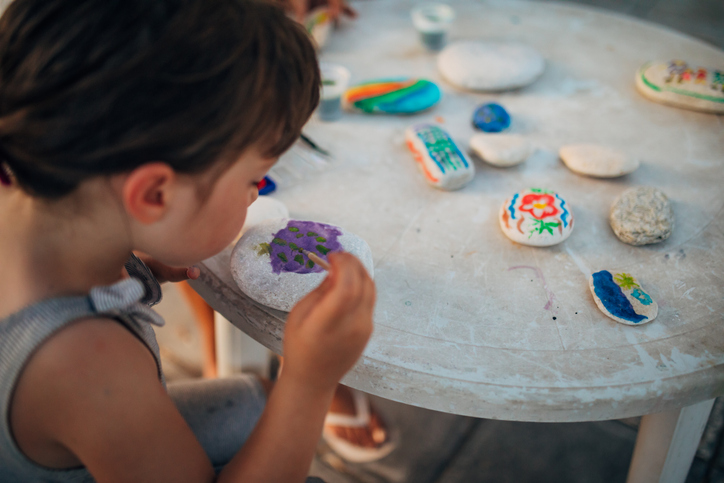When summer rolls around, I’m always on the hunt for ways to get the kids off their screens and into something creative and memorable. As a dad, I want to foster their imagination and create some quality bonding time without it feeling like a chore. That’s when I stumbled upon an idea that’s as simple as it is fun: rock painting. Trust me, it’s way more exciting than it sounds. With just a few garden rocks, some paint, and a little creativity, we turned a lazy afternoon into something magical.
Why Rock Painting?
First, it’s ridiculously easy to set up. Rocks are free (or very cheap), and they’re everywhere—your backyard, the local park, or even the garden center. Plus, rock painting taps into something special: the joy of transforming something ordinary into something extraordinary. For the kids, it’s like holding a blank canvas in their hands, only this time it’s a piece of nature. For me, it’s a chance to see their personalities shine through their creations.
Rock painting is also great for all ages. My younger kids love splashing color around without worrying too much about the outcome, while my older one gets super detailed with tiny brushes and intricate designs. And let’s not forget, it’s a mess that’s easy to clean up—music to any parent’s ears.
What You’ll Need
Before we dive into the artistic chaos, here’s a quick rundown of supplies. Don’t worry; you don’t need to raid an art store.
- Rocks: Smooth ones work best. Think flat stones that are easy to paint on.
- Acrylic paints: They’re vibrant, dry fast, and are more durable once applied.
- Paintbrushes: A mix of small and medium brushes works well for different designs.
- Paint pens: These are great for adding details or drawing outlines.
- Sealer: A clear spray or brush-on varnish to protect the designs from the elements.
- Palettes or paper plates: Perfect for mixing paint.
- Old clothes or aprons: Let’s just say kids and paint are not a clean combo.
Optional extras include glitter, googly eyes, or metallic paint for some extra pizzazz. We kept it simple, but feel free to go wild.
Preparing for the Fun
The first step is a mini rock-hunting adventure. I told the kids to find rocks they thought were “cool” or “looked like something”—like a heart, egg, or even a potato. This alone turned into a fun scavenger hunt that got them running around the yard.
Once we had our picks, we gave the rocks a quick wash. You’d be surprised how much dirt clings to them. After drying them in the sun, we were ready to set up our painting station. I laid out an old tablecloth on our patio, set out the supplies, and let the kids pick their spots. Everyone grabbed a rock, and the creativity began.
Let the Painting Begin
The beauty of rock painting is that there’s no right or wrong approach. My youngest decided her rock would be a “rainbow rock,” so she went for bold, colorful stripes. My son, on the other hand, decided he wanted his to look like a dinosaur egg, complete with tiny cracks and speckles. As for me, I opted for a simple smiling sun. It felt like a good fit for the day.
Here’s what made it fun:
- Themes: I suggested themes to guide them when they got stuck. Ideas like animals, cartoon characters, or even food shapes sparked their imaginations.
- Layering: We learned that bold colors might need two coats to really pop. This kept everyone occupied while they waited for the first layer to dry.
- Mistakes: There were no “ruined” rocks. If they smudged or didn’t like their design, we just painted over it and started again.
One thing that surprised me was how peaceful it felt. Sure, there was the occasional sibling squabble over paint colors, but for the most part, everyone was in the zone. Even I found myself getting lost in the process.
Adding the Finishing Touches
Once the paint had dried, we moved on to details. This is where paint pens came in handy for outlining shapes or adding small features like eyes or patterns. My oldest even used a toothpick for tiny dots, which gave her flower design an extra level of detail.
Before sealing the rocks, we let everything dry for at least an hour. The clear spray was the final touch, giving the rocks a glossy, professional look and making them waterproof. Pro tip: Do this step outside because the fumes can be strong.
What to Do with Your Masterpieces
Now that we had a pile of colorful, unique rocks, the big question was, “What do we do with them?” This turned into another fun brainstorming session. Here’s what we ended up doing:
- Garden decor: Some of the rocks found a new home around our flower beds and potted plants, instantly adding a pop of color.
- Paperweights: The dinosaur egg rock became my son’s new desk accessory.
- Gifts: The kids decided to paint rocks for their grandparents, complete with “I love you” messages.
- Kindness rocks: We placed a few painted rocks along a walking trail in our neighborhood, hoping they’d bring a smile to someone’s day.
Lessons Learned
What started as a simple summer activity turned into a surprisingly meaningful experience. Rock painting taught the kids patience (waiting for paint to dry isn’t easy), creativity, and even a bit of problem-solving. For me, it was a reminder to slow down and enjoy the little things—seeing the world through their eyes, one painted rock at a time.
It also reminded me that the best activities don’t need to be complicated or expensive. Sometimes, all it takes is a little paint, a handful of rocks, and a lot of imagination to turn an ordinary day into something extraordinary.
Why You Should Try This
If you’re a parent looking for a no-fuss way to spend quality time with your kids, I can’t recommend rock painting enough. It’s cheap, easy, and endlessly creative. Plus, the end result is something tangible—something you can keep, gift, or display. It’s a memory captured in paint, and that’s something money can’t buy.
So, the next time you hear the dreaded “I’m bored” chorus, grab some rocks, break out the paint, and let the fun begin. Who knows? You might just discover your inner artist, too.


